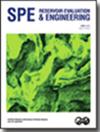Fluid Identification Derived from Formation Chlorine Measurements and Reservoir Characterization of Tight Carbonate in Sichuan Basin, China
IF 1.5
4区 工程技术
Q3 ENERGY & FUELS
引用次数: 0
Abstract
Natural gas production in the Sichuan Basin reached 30×109 m3 in 2020, but the shortfall between this and the production goal of 50×109 m3 in 2025 requires further exploration. The complex mineralogy and low porosity in tight carbonate reservoirs reduce the accuracy of formation water saturation calculations from Archie’s equation, which brings uncertainties to the reservoir characterization. Therefore, it is necessary to incorporate other methods as supplements to methods based on resistivities. In this paper, we outline a method that incorporates wireline-induced gamma spectroscopy, nuclear magnetic resonance (NMR), array dielectric, and borehole images. Spectroscopy is not only used to estimate the mineralogy of the reservoir, but it also provides measurements, such as chlorine concentration and thermal neutron capture cross section (sigma). The amount of chlorine in the formation is proportional to the water volume in the reservoir, hence formation water saturation. Sigma is also an indicator of the formation water saturation. It enables formation water saturation calculation without resistivity measurements. Case studies are presented from carbonate reservoirs in the Sichuan Basin, China. A robust and comprehensive petrophysical description of mineralogy, porosity, pore geometry, free fluid volume, rock type, and formation water saturation is presented. Calculation of formation water saturation from chlorine and sigma proves to be successful in both water-based mud and oil-based mud (OBM) environments. The depth of investigation (DOI) of chlorine from spectroscopy is about 8 to 10 in. for 90% of the signal. The various DOIs of different measurements must be considered when performing the fluid identification. Bound fluid saturation can reach more than 50% in tight carbonate reservoirs. Formation water saturation is not the only factor that determines the fluid type. Free fluid saturation from NMR must also be incorporated. Finally, a robust methodology integrating formation water saturation derived from dielectric and spectroscopy, and free fluid saturation derived from NMR shows great advantage in fluid identification in tight carbonate reservoirs. In this paper, we discuss a novel combination of wireline logging tools for fluid identification in a tight carbonate reservoir in the Sichuan Basin. It reduces the uncertainty when estimating formation water saturation and when resistivity measurements are suppressed in OBM environments. The gas zones identified by the new method have promising predictions of gas production. This workflow can also be applied to other tight carbonate plays in China.四川盆地致密碳酸盐岩储层特征及储层氯含量的流体识别
四川盆地2020年天然气产量达到30×109 m3,但与2025年50×109 m3的产量目标尚有差距,需要进一步勘探。致密碳酸盐岩储层的复杂矿物学和低孔隙度降低了用Archie方程计算地层含水饱和度的准确性,给储层表征带来了不确定性。因此,有必要采用其他方法作为基于电阻率的方法的补充。在本文中,我们概述了一种结合线感应伽马能谱、核磁共振(NMR)、阵列介电介质和井眼图像的方法。光谱学不仅用于估计储层的矿物学,而且还提供测量,如氯浓度和热中子捕获截面(sigma)。地层中氯的含量与储层中的水体积成正比,即地层含水饱和度。Sigma也是地层含水饱和度的指标。无需电阻率测量即可计算地层含水饱和度。以四川盆地碳酸盐岩储层为例进行了研究。给出了矿物学、孔隙度、孔隙几何、自由流体体积、岩石类型和地层含水饱和度的可靠而全面的岩石物理描述。事实证明,在水基泥浆和油基泥浆(OBM)环境中,用氯和西格玛计算地层含水饱和度都是成功的。氯的光谱研究深度(DOI)约为8至10英寸。对于90%的信号。在进行流体识别时,必须考虑不同测量值的不同深度。致密碳酸盐岩储层束缚流体饱和度可达50%以上。地层含水饱和度并不是决定流体类型的唯一因素。从核磁共振的自由流体饱和度也必须纳入。最后,结合电介质和光谱学得出的地层含水饱和度和核磁共振得出的自由流体饱和度的方法在致密碳酸盐岩储层流体识别中具有很大的优势。本文讨论了一种用于四川盆地致密碳酸盐岩储层流体识别的新型电缆测井组合方法。它减少了估算地层含水饱和度时的不确定性,以及在OBM环境中电阻率测量受到抑制时的不确定性。新方法确定的含气层具有良好的产气量预测。该工作流程也可应用于中国其他致密碳酸盐岩储层。
本文章由计算机程序翻译,如有差异,请以英文原文为准。
求助全文
约1分钟内获得全文
求助全文
来源期刊
CiteScore
5.30
自引率
0.00%
发文量
68
审稿时长
12 months
期刊介绍:
Covers the application of a wide range of topics, including reservoir characterization, geology and geophysics, core analysis, well logging, well testing, reservoir management, enhanced oil recovery, fluid mechanics, performance prediction, reservoir simulation, digital energy, uncertainty/risk assessment, information management, resource and reserve evaluation, portfolio/asset management, project valuation, and petroleum economics.

 求助内容:
求助内容: 应助结果提醒方式:
应助结果提醒方式:


